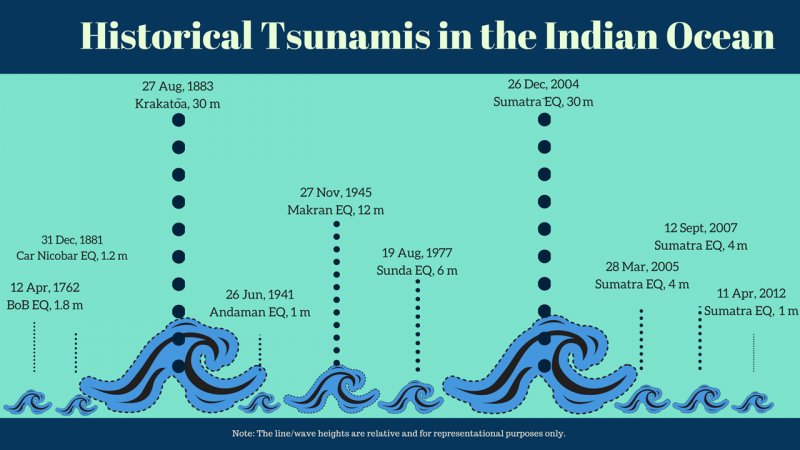
Thirteen years ago, the fateful morning of 26th December 2004 swept away over 230,000 lives across fourteen countries bordering the Indian Ocean. India was one of them where 10,749 lives were lost in Tamil Nadu, Andhra Pradesh, Kerala, Puducherry and the Andaman and Nicobar Islands. The devastating ‘tsunami’ also caused huge damages to property in the affected countries. The reason of this ‘tsunami’ was attributed to a major earthquake which measured 9.3 in the Richter scale, with its epicentre off the west coast of Sumatra, Indonesia.
Until then, not many around the world recognised or had even heard of the word ‘tsunami’ since it had occurred only about 5 or 6 times over the last few centuries. Literally meaning ‘harbour wave’ in the Japanese language, the word now refers to a large wave in the ocean, usually caused by an earthquake or volcanic eruption.
Apart from the sheer magnitude (it was the second strongest earthquake recorded so far!), what made matters worse about the 2004 tsunami was our lack of preparedness. None of the affected countries, including India, had any system for early warning of such tsunamis, nor was there a plan for emergency response. There was no information available regarding real-time monitoring of earthquakes, or the changes in sea level. Hence, the huge waves caught us all off guard.
Learning a lesson and resolving never to face a repeat of such situations, the Government of India responded by establishing the state-of-the-art Indian Tsunami Early Warning Centre (ITEWC) at the Indian National Centre for Ocean Information Services (INCOIS). Started off as an integrated effort from different organisations under the Ministry of Earth Sciences, the Department of Space (DoS), Department of Science and Technology (DST), the Council for Scientific and Industrial Research (CSIR), Survey of India and the National Institute of Ocean Technology (NIOT), ITEWC became fully operational in 2007. Its major objective is to detect, locate, and determine earthquakes in the Indian Ocean that could result in a tsunami.
So, how does the Indian Tsunami Early Warning System (ITEWS) work to keep on an eye on the ocean? It has a real-time observation network of seismic stations that look out for earthquakes in the Indian Ocean region, a numerical model to make a first guess on the probability for the generation of tsunami due to the potential earthquake and to estimate the likely wave heights and time of arrivals along the coast, Bottom Pressure Recorders (BPR) to record the pressure in the depth of the oceans, tide gauges to measure the waves and a 24X7 operational warning centre. Based on the first guess and the recorded parameters, the warning system sends timely tsunami advisories as ‘Warning’, ‘Alert’ or ‘Watch’ to communities living on the edge of the ocean. In addition, the system is supported with a scenario database with all possible earthquake scenarios, a vulnerability model to predict the locations that are vulnerable, an updated Decision Support System that decides the action to be taken based on the situation, and a newly developed dissemination server that can send messages over telephone, fax, text messages and emails simultaneously, explains Dr. Pattabhi Rama Rao of the ITEWC.
Since its establishment, the warning system has tasted success quite a few times. In April 2012, for example, it issued a warning to Nicobar Islands about a tsunami that triggered off the coast of Sumatra. This was reported as a study in journal Current Science. However, the occurrence of tsunamis in the Pacific Ocean on March 11, 2011 that jeopardised the Fukushima nuclear reactor in Japan, and the twin earthquakes of 2012 in the the Indian Ocean, have brought to the fore the need to improve the accuracy of such tsunami warning systems.
While machines and computers can do their job, it is the people who eventually need to act in the time of disaster. “With all the science enabling us to assess the potential threats and issue bulletins, it would not be sufficient as it will require all other stakeholders to take cognizance and take appropriate actions” notes Dr. S. S. C. Shenoi, Director, INCOIS. Hence, ITEWC is working with coastal communities in the country to improve awareness and preparedness for such natural disasters. Twice a year communication tests and Mock Tsunami Drill (IOWave16 Exercise and Multi State mega mock exercise in November 2017), for example involves stakeholders from the central and state governments who are stakeholders in protecting lives and property.
Powered with the progress of science, we are now able to predict and act against natural disasters like a tsunami, if not stop them. But, the success of such missions rest on a holistic system that depends on machines and people. “Capacity building through workshops, drills and communication tests can help us avoid a scenario like 2004. In addition, our collaboration with international agencies in real-time monitoring will help support each other during emergencies. With exciting plans for the future, the centre aims to make our coasts safe for all”, signs off Dr. Shenoi.






